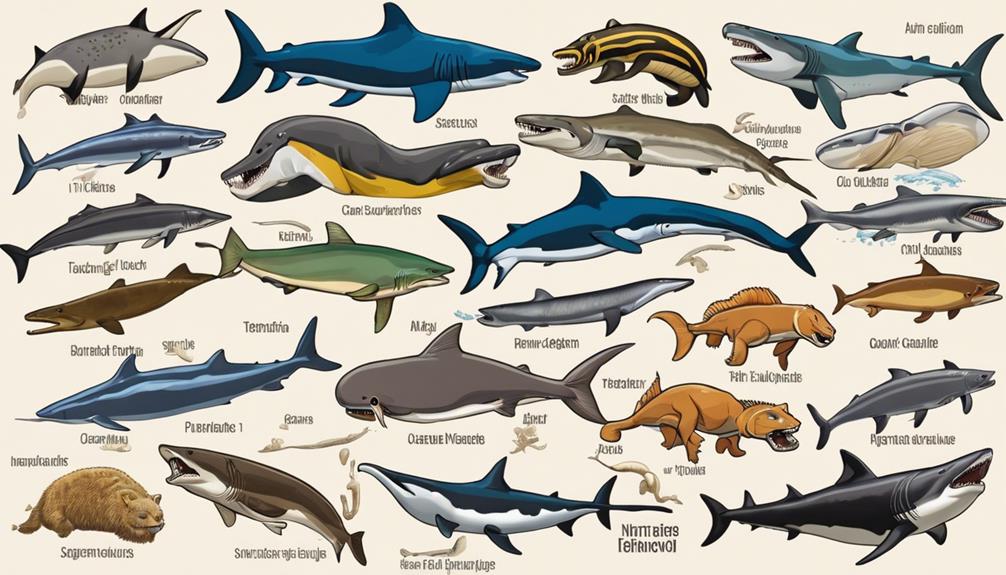Ever pondered the coexistence of grace and ferocity in the ocean's depths?
Picture the elegance of a blue marlin slicing through the water alongside the sheer power of a killer whale on the prowl. These apex predators command respect and awe, but there's more to their stories waiting to be uncovered.
Stay tuned to unravel the intricate web of survival instincts, hunting prowess, and symbiotic relationships that shape the domain of ocean carnivores.
The mysteries of the deep blue are calling, beckoning you to uncover the untold tales of these majestic creatures.
Blue Marlin
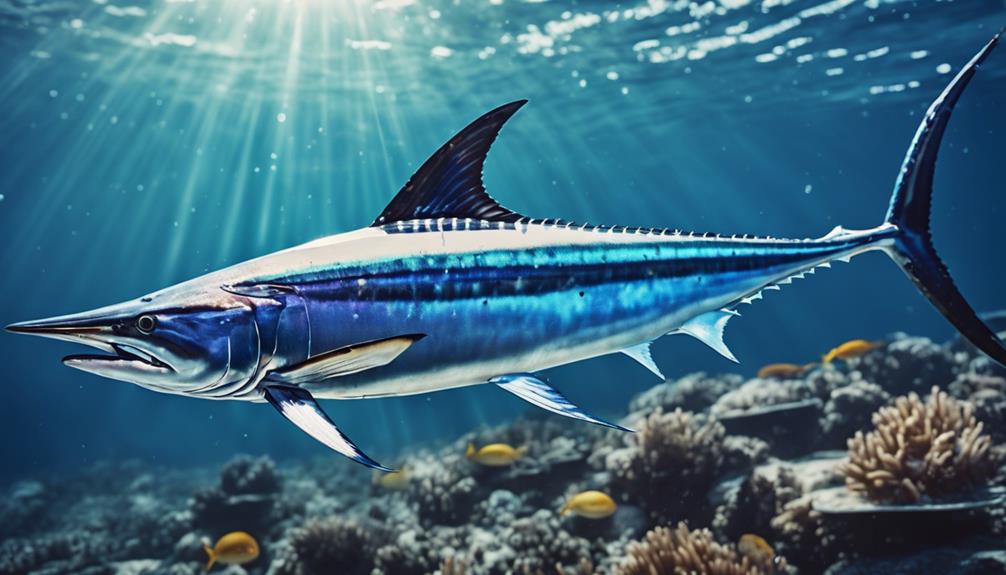
Plunge into the world of the Blue Marlin, a majestic ocean predator known for its impressive size and long-distance hunting skills. As you explore the depths of the ocean, picture yourself encountering this mighty creature. With a length that can reach up to 16 feet, the Blue Marlin commands attention with its sleek body and sharp bill designed for swift strikes.
Imagine witnessing the Blue Marlin in action as it fiercely pursues various large fish across vast distances. Its hunting prowess is unmatched, showcasing a strategic approach that highlights its place as a top predator in the marine ecosystem. With each powerful movement, the Blue Marlin exemplifies agility and strength, making it a formidable force beneath the waves.
Intriguing and awe-inspiring, the Blue Marlin's presence in the ocean serves as a reminder of the diverse and dynamic nature of marine life. So, as you explore the depths of the sea in your mind's eye, remember the remarkable Blue Marlin and its essential role in maintaining the delicate balance of the underwater world.
Dolphins
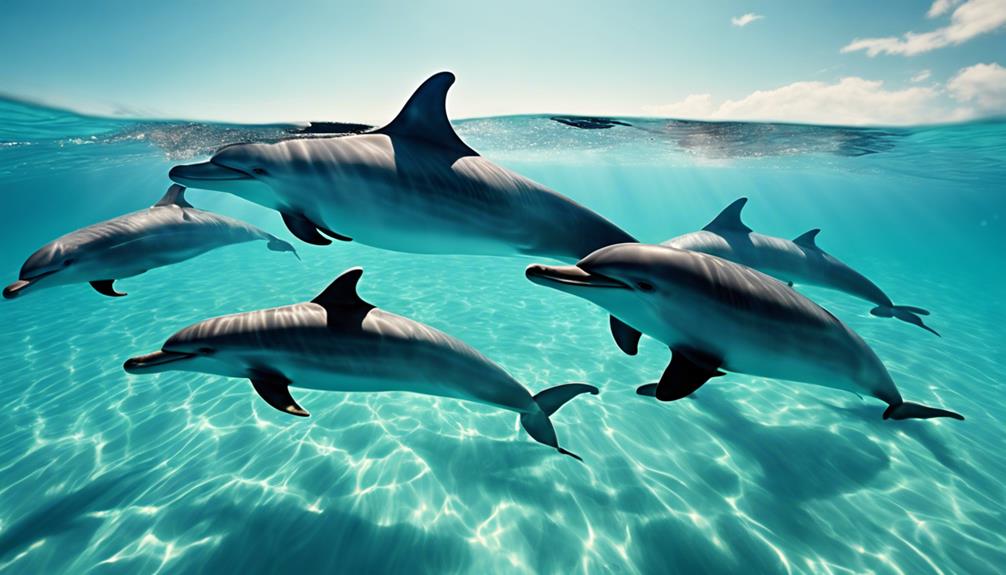
Plunge into the world of dolphins, intelligent marine mammals that consume 25 to 50 pounds of fish daily. Dolphins, known for their playful nature, are also skilled hunters in the ocean. With their sharp teeth and streamlined bodies, they use cooperative strategies when hunting, surrounding schools of fish to feed efficiently. These majestic creatures showcase remarkable intelligence, often displaying problem-solving skills and complex social behaviors.
Dolphins primarily feed on a variety of fish species, including herring, mackerel, and squid, adapting their diet based on prey availability in different regions. Their hunting techniques vary depending on the species, with some using echolocation to locate prey in murky waters. Dolphins' agile movements and high speeds enable them to chase down fast-swimming fish, showcasing their prowess as top marine predators.
Furthermore, dolphins' hunting tactics contribute to the delicate balance of marine ecosystems, regulating fish populations and maintaining biodiversity. By exploring the world of dolphins, you gain insight into the intricate dynamics of ocean carnivores and their essential role in the underwater food chain.
Great White Shark
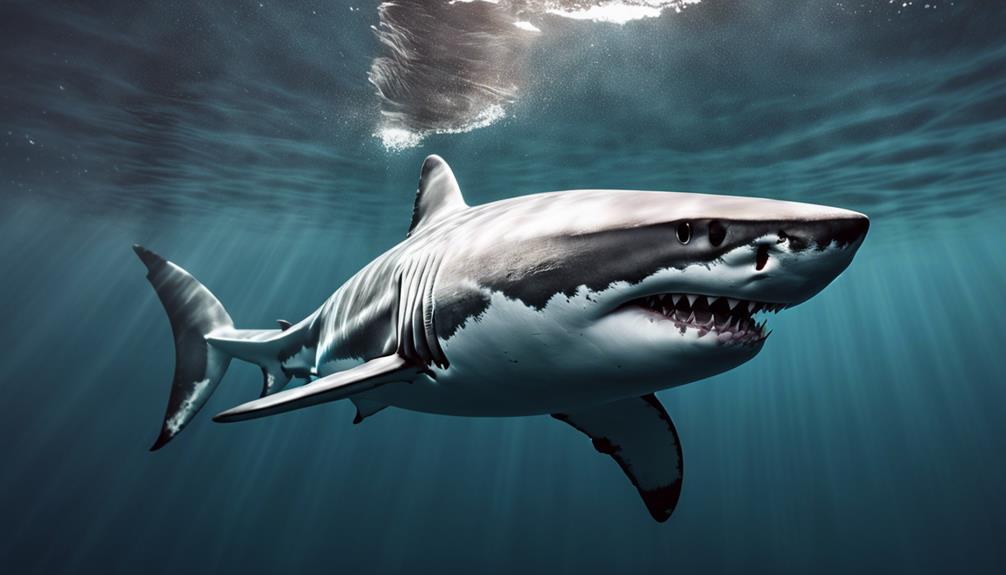
The Great White Shark's reputation as a formidable apex predator in the ocean is unparalleled. With its sleek, powerful body and rows of razor-sharp teeth, this magnificent creature strikes fear in the hearts of many. As a top predator, you play a critical role in maintaining the balance of the marine ecosystem.
Your hunting prowess is unmatched, capable of reaching speeds up to 25 miles per hour when ambushing prey from below. Your exceptional sense of smell allows you to detect even the faintest traces of blood in the water from miles away, making you a skilled and efficient hunter.
Despite your fierce reputation, human activities such as overfishing and pollution pose significant threats to your population. Conservation efforts are essential to vital the survival of your species and the health of the oceans you inhabit.
As a Great White Shark, you're a majestic and powerful creature, deserving of respect and protection in our vast and awe-inspiring oceans.
Killer Whale
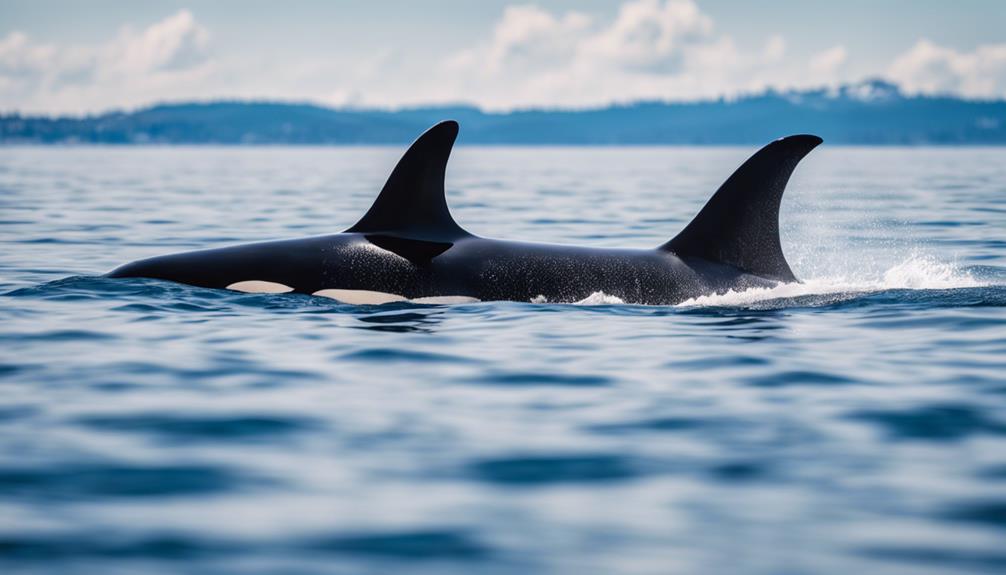
Majestic hunters of the sea, Killer Whales, also known as orcas, command respect with their intelligence and strategic hunting techniques. These powerful predators are found in oceans worldwide, known for their distinct black and white coloring. Orcas are highly social animals, often traveling in pods and exhibiting complex communication skills through vocalizations and body language.
Killer Whales are formidable carnivores, preying on a variety of marine animals such as fish, seals, and even other whales. They showcase remarkable hunting strategies, including cooperative hunting where they work together to capture prey effectively. Orcas are also known for their ability to adapt their hunting techniques based on the type of prey they're targeting.
With their sharp teeth and powerful bodies, Killer Whales are apex predators in the ocean, playing a critical role in maintaining the balance of marine ecosystems. Their intelligence, agility, and hunting prowess make them one of the most fascinating creatures in the sea.
Polar Bear
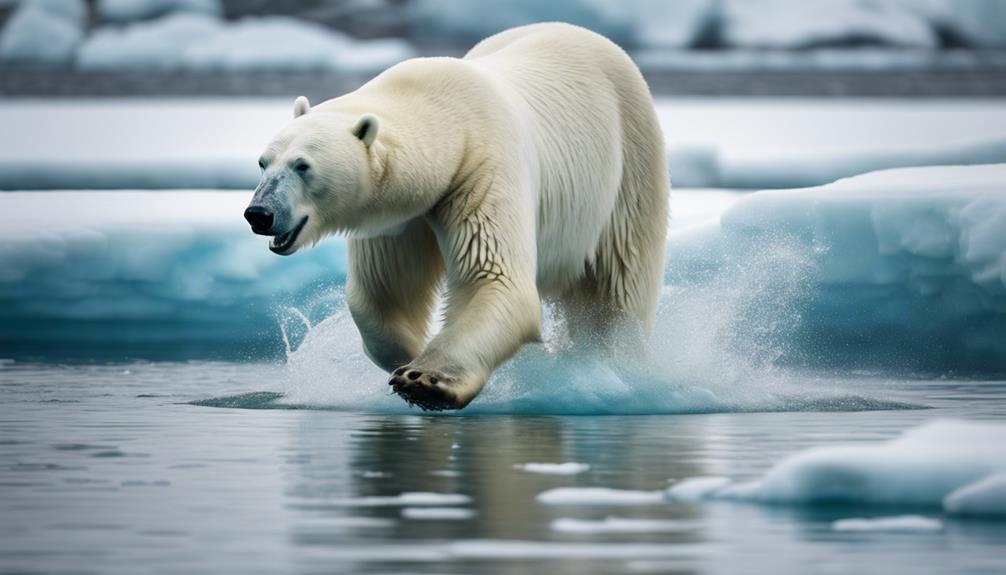
Moving from the ocean to the icy Arctic regions, the Polar Bear emerges as a formidable predator in its frozen habitat. With a thick layer of insulating blubber and a dense fur coat, Polar Bears are well-equipped to thrive in the extreme cold. These massive carnivores primarily hunt seals, relying on their keen sense of smell to detect breathing holes in the ice where seals surface. Once located, Polar Bears use their powerful limbs to break through the ice and ambush their unsuspecting prey.
These apex predators are expert swimmers, able to cover long distances in search of food. Despite their cute appearance, they're solitary hunters and highly territorial. Climate change poses a significant threat to their survival as melting ice reduces their hunting grounds and food sources. Conservation efforts are vital to protecting these magnificent creatures and preserving the delicate Arctic ecosystem they call home.
Tiger Shark
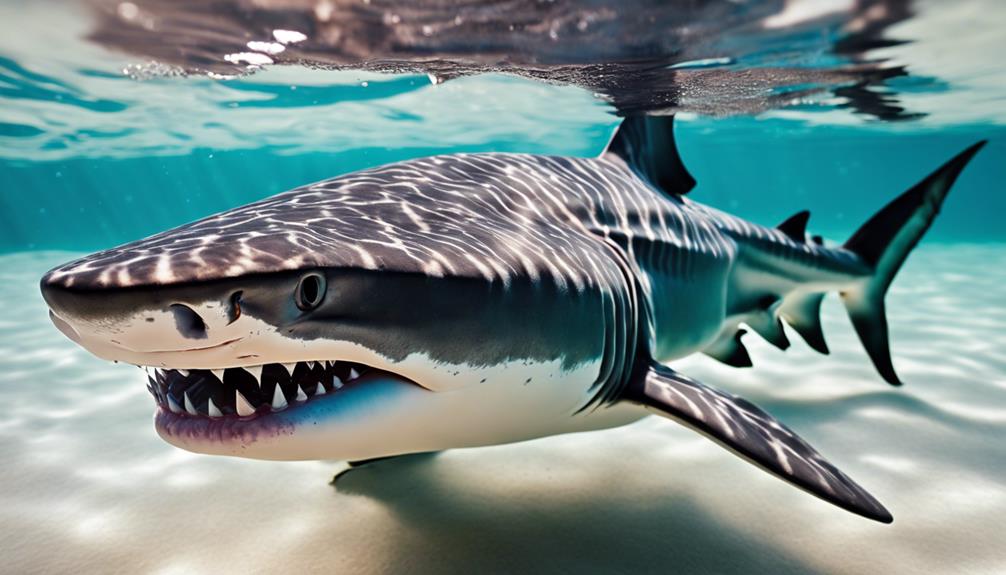
Roaming the ocean depths with stealth and precision, Tiger Sharks embody the essence of formidable predators. Known for their distinct stripes that fade as they mature, these apex predators strike fear into the hearts of many marine creatures. With powerful jaws and serrated teeth, Tiger Sharks aren't picky eaters, consuming anything from fish and seals to birds and even other sharks.
These majestic creatures can grow up to 16 feet in length and are equipped with incredible senses, including sharp eyesight and acute smell, allowing them to detect the slightest hint of blood from miles away. Their hunting strategy involves patience and ambush, often surprising their prey with lightning-fast attacks. Despite their fierce reputation, Tiger Sharks play an essential role in maintaining the balance of ocean ecosystems by controlling populations of various marine species.
Encountering a Tiger Shark in the wild is a thrilling yet humbling experience, a reminder of the sheer power and beauty that these creatures possess in the vast expanse of the ocean.
Swordfish
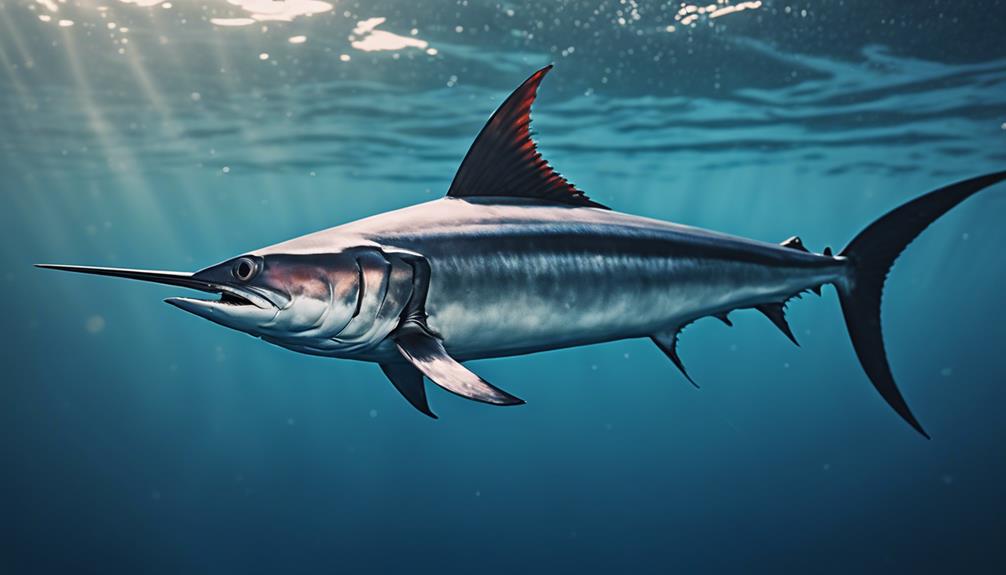
Tiger Sharks, powerful apex predators of the ocean, exemplify the importance of maintaining ecosystem balance through their hunting prowess and role in controlling marine populations. Now, shifting our focus to the Swordfish, we explore another fascinating carnivore of the sea.
Swordfish, with their distinctive elongated bill resembling a sword, are agile hunters known for their remarkable speed. These creatures can reach speeds of up to 60 miles per hour, making them one of the fastest swimmers in the ocean. Their sleek bodies and powerful tails enable them to slice through the water with precision as they pursue their prey.
Equipped with sharp, sword-like bills, Swordfish use them to slash at schools of fish, stunning or impaling their prey before consuming them. Their diet primarily consists of squid and various fish species. Swordfish are opportunistic feeders, utilizing their speed and agility to catch prey in the vast open ocean.
Observing Swordfish in their natural habitat showcases the marvel of evolution and the intricate balance of predator-prey relationships in the marine ecosystem.
Barracuda
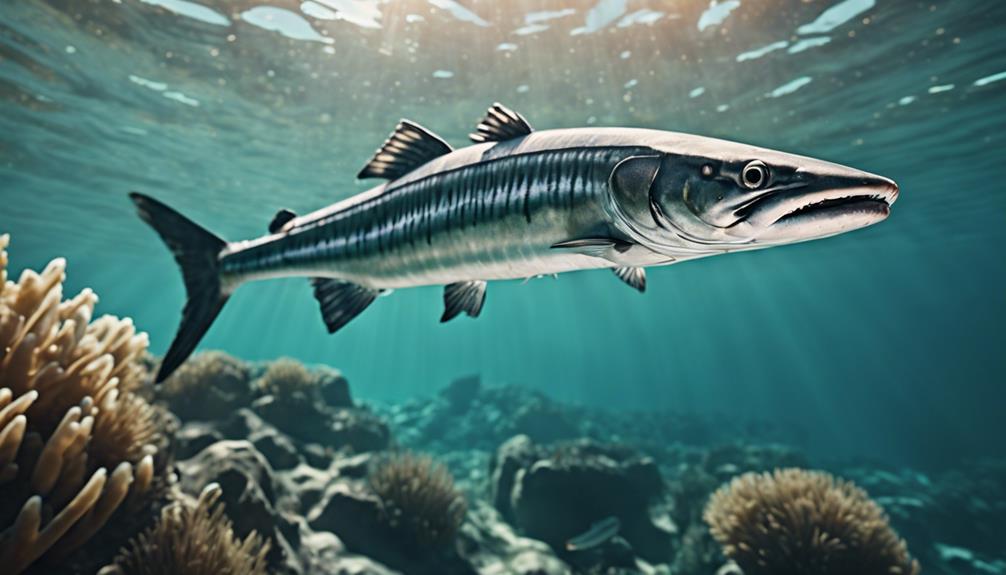
With their sleek bodies and razor-sharp teeth, Barracudas are important predators of the ocean, known for their swift and aggressive hunting tactics. These fish, often found in tropical and subtropical waters, rely on their speed and stealth to ambush their prey. Barracudas can reach impressive speeds of up to 27 miles per hour, allowing them to swiftly chase down smaller fish with ease.
Their elongated bodies and powerful jaws filled with long, pointed teeth make them efficient hunters. Barracudas primarily feed on fish, using their sharp teeth to tear through their prey. Their hunting strategy involves lurking near reefs or in open water, waiting for the right moment to strike with a sudden burst of speed.
Despite their fearsome reputation as predators, barracudas also face threats from larger fish, sharks, and even humans who fish them for sport. These creatures play an important role in ocean ecosystems, helping to regulate fish populations and maintain a balance in the underwater food chain.
Moray Eel
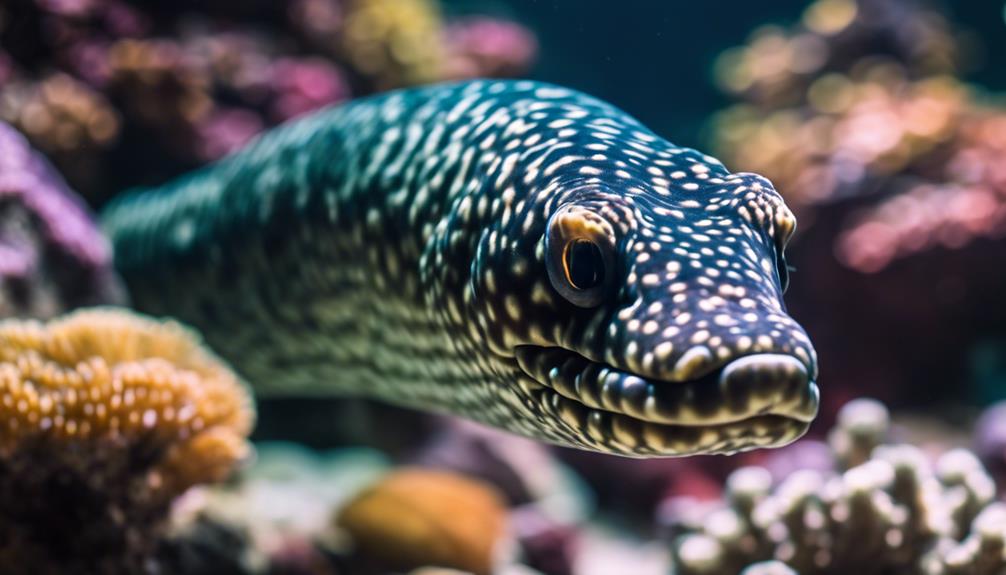
The Moray Eel, a fascinating predator of the ocean depths, possesses a unique and intimidating presence with its elongated body and powerful jaws. This carnivorous creature, known for its snake-like appearance, inhabits crevices and holes in coral reefs or rocky areas.
With excellent sense of smell and sharp teeth, Moray Eels are skilled hunters preying on fish, octopuses, and crustaceans. Their method of capturing prey involves seizing them with their strong jaws and then pulling them into their throat using a second set of jaws located in the back of their throat.
Despite their fearsome reputation, Moray Eels are generally shy and avoid interactions with humans unless provoked. They come in various colors and patterns, blending in with their surroundings for ambush hunting. Their ability to open and close their mouths rapidly helps them in creating a suction force to catch prey efficiently.
Observing a Moray Eel in its natural habitat is a thrilling experience, showcasing the beauty and ferocity of this ocean predator.
Leopard Seal
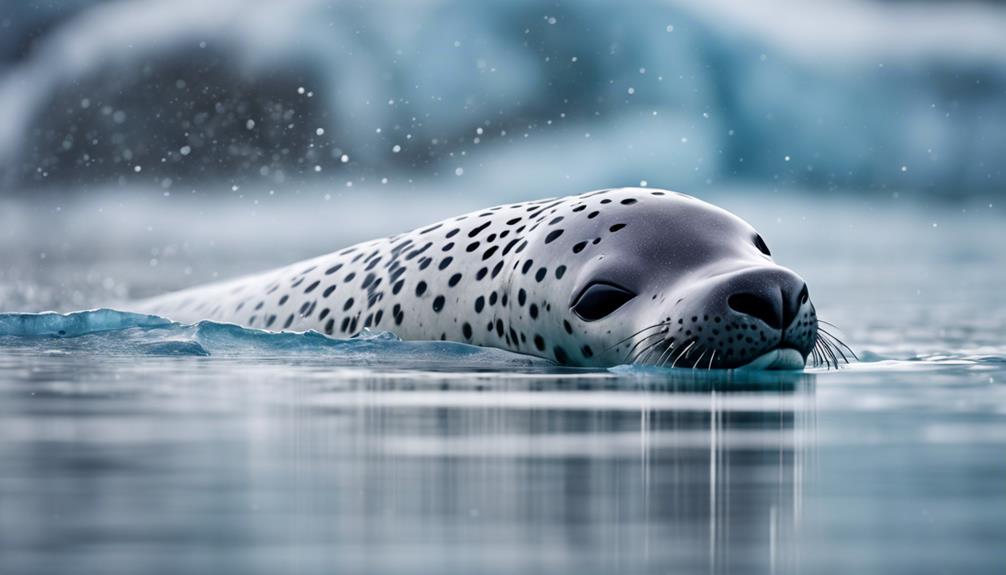
In the icy waters of Antarctica, you can encounter the formidable predator known as the Leopard Seal. With its sleek, muscular body and distinctive spotted coat, this apex predator is a sight to behold. Leopard Seals are expert hunters, preying on a variety of animals including penguins, fish, and even other seals. Their large jaws and sharp teeth make them efficient carnivores in the frigid Antarctic waters.
These seals are known for their agility and speed in the water, allowing them to chase down prey with ease. Their diet consists mainly of krill and fish, but they're also capable of taking down larger animals due to their size and strength. Despite their cute appearance, Leopard Seals are powerful predators that play an important role in the Antarctic food chain.
Encounters with these magnificent creatures are a thrilling experience for those brave enough to venture into their icy habitat. Their presence serves as a reminder of the beauty and brutality of nature in one of the world's most extreme environments.
Humboldt Squid
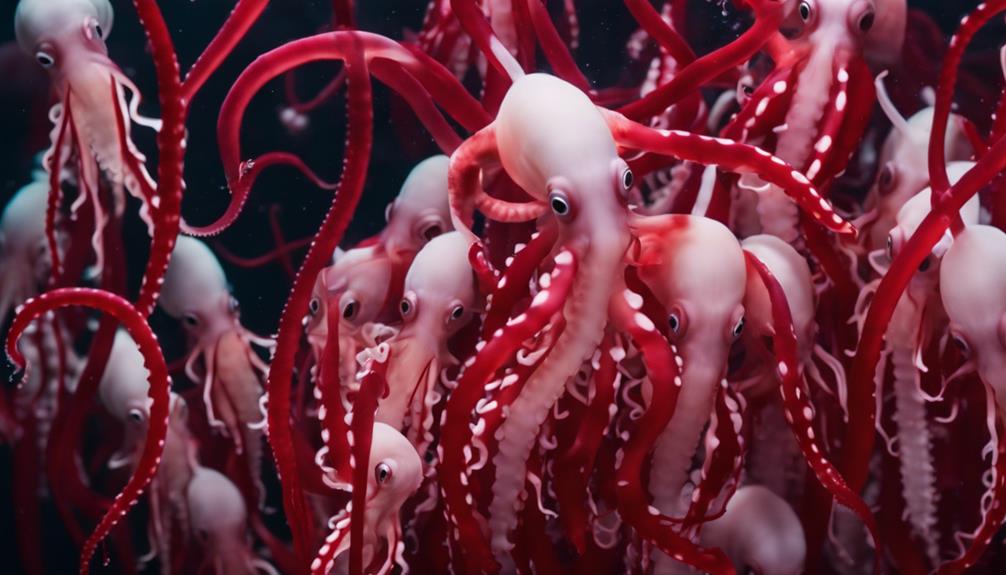
Humboldt Squid exemplify ferociousness in the depths of the ocean. These creatures, also known as jumbo squid, can grow up to 6 feet long and are formidable predators with a reputation for their aggressive hunting behavior. Found in the Eastern Pacific Ocean, they possess keen intelligence and remarkable adaptability, enabling them to thrive in diverse environments.
Their reddish-brown skin, studded with chromatophores, allows them to rapidly change color, aiding in communication and camouflage. Equipped with powerful beaks and serrated suckers on their tentacles, Humboldt Squid are efficient hunters capable of taking down fish, crustaceans, and even other squid. They often hunt in groups, displaying complex social behaviors and coordination during their predatory pursuits.
Despite their deep-sea habitat, Humboldt Squid are known to surface to feed, making them a fascinating subject of study for marine biologists. Their role as top predators in the ocean ecosystem highlights their importance in maintaining the balance of marine life.
Saltwater Crocodile
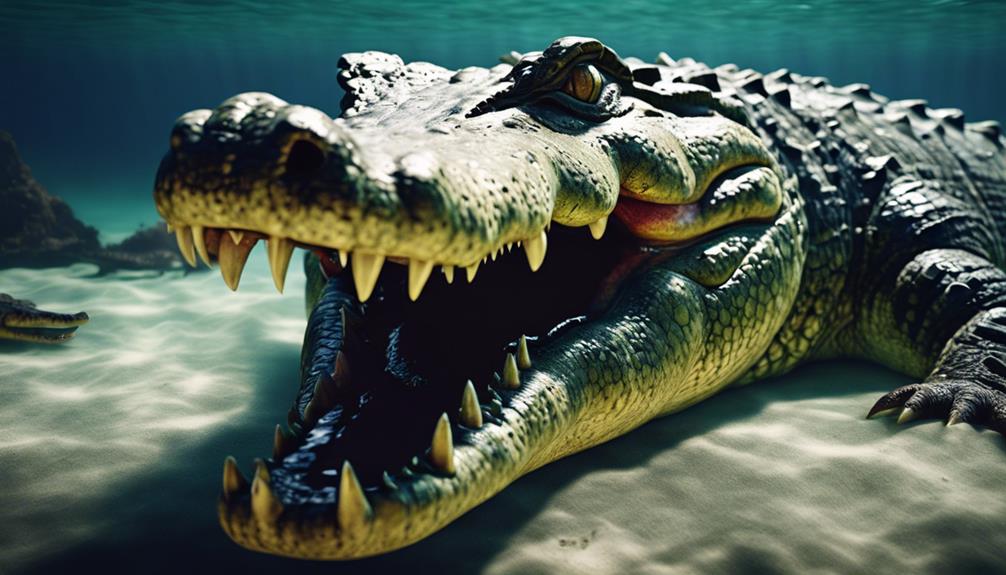
Exemplifying strength and stealth in aquatic dominions, the Saltwater Crocodile commands attention as a formidable predator of the ocean. Dominating estuaries, mangroves, and even venturing into the open sea, these crocodiles are adept at blending into their surroundings, waiting patiently for unsuspecting prey to come within striking distance.
With powerful jaws capable of delivering a bone-crushing bite force, they can take down large marine creatures, such as fish, turtles, and even sharks. Their ability to launch surprise attacks from the water's edge makes them a fearsome presence in coastal areas, striking fear into both marine animals and humans alike.
Despite their large size and sometimes sluggish appearance, Saltwater Crocodiles are surprisingly agile and swift when it comes to hunting. Their role as apex predators in their habitats is important for maintaining the balance of the ecosystem, showcasing the important role they play in the ocean's food chain.
Giant Pacific Octopus
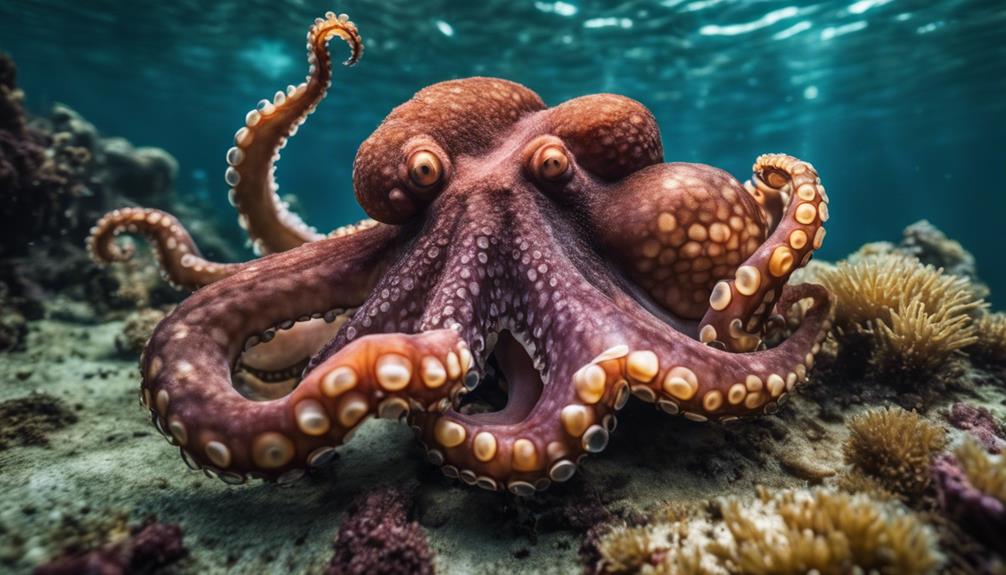
Displaying remarkable intelligence and adaptability, the Giant Pacific Octopus captivates with its intricate behavior and mesmerizing abilities in the underwater domain.
As you observe this creature, you'll notice its unique features, including eight arms lined with suction cups that aid in capturing prey and exploring its surroundings with precision. The Giant Pacific Octopus is a formidable carnivore, preying on crabs, clams, and even small fish using its camouflage abilities to blend seamlessly into its environment.
One of the most fascinating aspects of this octopus is its impressive problem-solving skills, allowing it to open jars, manipulate objects, and showcase its intelligence in various experiments. As you plunge deeper into the world of the Giant Pacific Octopus, you'll discover its mysterious nature and the enigmatic ways it interacts with its environment.
Witnessing this creature in action provides a glimpse into the complexity and beauty of the ocean's carnivorous inhabitants.

Erzsebet Frey (Eli Frey) is an ecologist and online entrepreneur with a Master of Science in Ecology from the University of Belgrade. Originally from Serbia, she has lived in Sri Lanka since 2017. Eli has worked internationally in countries like Oman, Brazil, Germany, and Sri Lanka. In 2018, she expanded into SEO and blogging, completing courses from UC Davis and Edinburgh. Eli has founded multiple websites focused on biology, ecology, environmental science, sustainable and simple living, and outdoor activities. She enjoys creating nature and simple living videos on YouTube and participates in speleology, diving, and hiking.
🌿 Explore the Wild Side!
Discover eBooks, guides, templates and stylish wildlife-themed T-shirts, notebooks, scrunchies, bandanas, and tote bags. Perfect for nature lovers and wildlife enthusiasts!
Visit My Shop →
